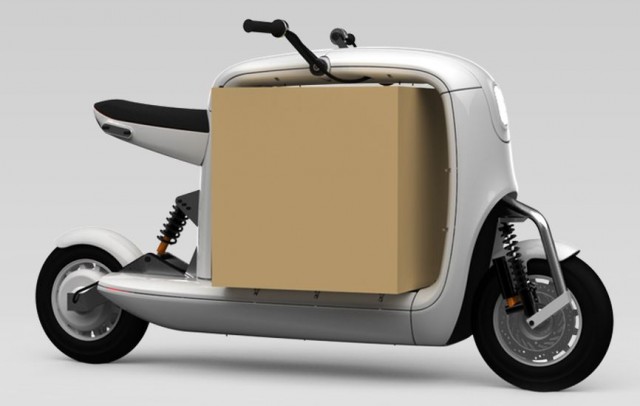You’ve seen them put-putting along the roadside and bike trails, piloted by some ‘weirdo’ or other social outcast. Or were those nutjobs actually visionaries – early adopters of a world-changing technology?

Scooters don’t have to be ugly, short-range puddle-jumpers. Retro-fit gasoline-chassis scooters provide heavy suspension, large wheels and and smooth ride, while maintaining all the benefits of electric power.
E-bikes – electric scooters with vestigial pedals – hit the market in Asia about a decade ago, where they have have seen widespread, rapid adoption. The first models landed on North American shores about 5 years ago to a lukewarm reception, though their welcome is quickly warming.
This is the first in a series of articles which will chronicle my household’s decision to reduce our reliance on gasoline, eliminate some pollution, and hopefully save a few bucks in the process. Welcome to Ebike Nation!
What’s an E-Bike, and what are the rules?
“E-Bike” can refer to a number of different vehicles, but it usually denotes one of two things:
- A standard-frame bicycle fitted with a battery and electric motor
- A full electric-powered scooter with pedals as a backup
 Electric-assist bicycles have been around for a long time, and we’ve personally been using them here for about 5 years. Scooters are just recently starting to see real proliferation with the introduction of long-life lithium (LiFePO4) batteries, though many older models with lead-acid batteries are still available.
Electric-assist bicycles have been around for a long time, and we’ve personally been using them here for about 5 years. Scooters are just recently starting to see real proliferation with the introduction of long-life lithium (LiFePO4) batteries, though many older models with lead-acid batteries are still available.
The laws surrounding ebikes vary from jurisdiction to jurisdiction, but in general, both are treated like a regular bicycle, with all the same allowances and restrictions. In Ontario specifically:
- No drivers license required.
- Must be 16 to drive.
- No vehicle license or registration.
- No insurance required.
Of course, your region’s regulations may be different, so check with your transportation ministry and municipality to be sure of any applicable laws.
Justifying the Purchase
In June of 2013, I decided to take the plunge and picked up a shiny new ebike to replace one of the family vehicles. After a bit of research and window shopping, I zeroed in on a high-end, heavy-duty, long-range commuter bike. At $2000+ my wife and I had high expectations for the ‘value proposition’ of this bike as a true car replacement.
To run a domestic (read: cheap) commuter vehicle, including licensing, registration, insurance and of course lease/payments, you’re looking at about $650/month before gas and maintenance. For a small vehicle, gas consumption averages about $200/month, and you can triple that for an SUV or longer commutes.
 So the average Canadian is spending (conservatively) $850/month to own and operate a small domestic commuter vehicle, and about $1200/month for a van or SUV/crossover. You can fact-check our numbers here or here or here.
So the average Canadian is spending (conservatively) $850/month to own and operate a small domestic commuter vehicle, and about $1200/month for a van or SUV/crossover. You can fact-check our numbers here or here or here.
Depending on your needs, an e-bike will range from $1200 to $2500. Battery charging costs are essentially negligible, with the first month running me $3 in electricity. Even replacing a small, infrequently used vehicle with a deluxe electric bike should pay for itself in less than 3 months. Plugging in these numbers, and factoring inthe rising cost of gas ($1.33/l today) commuting on the grid will save you $30k or more in the first 3 years.
In the case where you’re keeping your car and using the ebike for around-town to save gas, you’ll have to punch in your own numbers. My own experience is to expect around $200 in savings monthly, which puts you in the 1-year timeframe for payoff. Still pretty decent.
Compared to owning a car, the financial benefits of owning an e-bike are extremely attractive, but how reasonable is it to expect to replace a full-on car with an ebike?
Capabilities
Everyone’s vehicle fills a different role for them. A flooring contractor won’t be scooting around town on an ebike, and your silk suit might not like the rain. Here’s what we laid out as our own requirements:
- Commuting to/from workplaces with one-way distances of 15 and 40 km.
- Grocery and other shopping trips
- Traveling to client meetings
- Transporting kids to activities (swimming, climbing, music lessons, etc)
The bikes have been able to fulfill these roles with aplomb, however sometimes it is simply not practical. Large grocery runs still require a lot of storage space, and snow on the ground makes travel on two tires unsafe.

Electric scooters have evolved and are capable of more than you may think. Among the myriad manufacturers, you are almost certain to find a model to suit your needs.
Still however, we’ve found ways to overcome many issues: proper outerwear for rain/cold offsets the discomfort of exposure, and adding more storage to the bike allows for more substantial grocery and other shopping. There are even snow tires available for ebikes! We will cover all of these remedies in detail in future articles.
Is it for you?
Short answer: “probably”, provided you are willing to commit to educate yourself and exchange a bit of luxury for environmental and economic benefit. Even if you cannot reasonably expect to commute or replace a car with an ebike, the general around-town type functionality will still offset the cost of the purchase fairly quickly. If you’re smart about battery and chassis selection (more to come on this), you can expect several years of service from a good ebike, and more importantly, the realization that you are not belching pollutants out the back of your ride will keep you motivated to saddle-up instead of fill-up.
 In upcoming articles, we will go into much more depth on topics such as battery technology, brands and dealerships, outerwear, gadgets, safety, environmental impact, and even maintenance and retrofits. We’ll also be launching a new site EbikeNation.ca with discussion boards, more articles and lots of in-depth reviews. Stay tuned and check back frequently for the latest on this new trend in clean, cheap transportation!
In upcoming articles, we will go into much more depth on topics such as battery technology, brands and dealerships, outerwear, gadgets, safety, environmental impact, and even maintenance and retrofits. We’ll also be launching a new site EbikeNation.ca with discussion boards, more articles and lots of in-depth reviews. Stay tuned and check back frequently for the latest on this new trend in clean, cheap transportation!